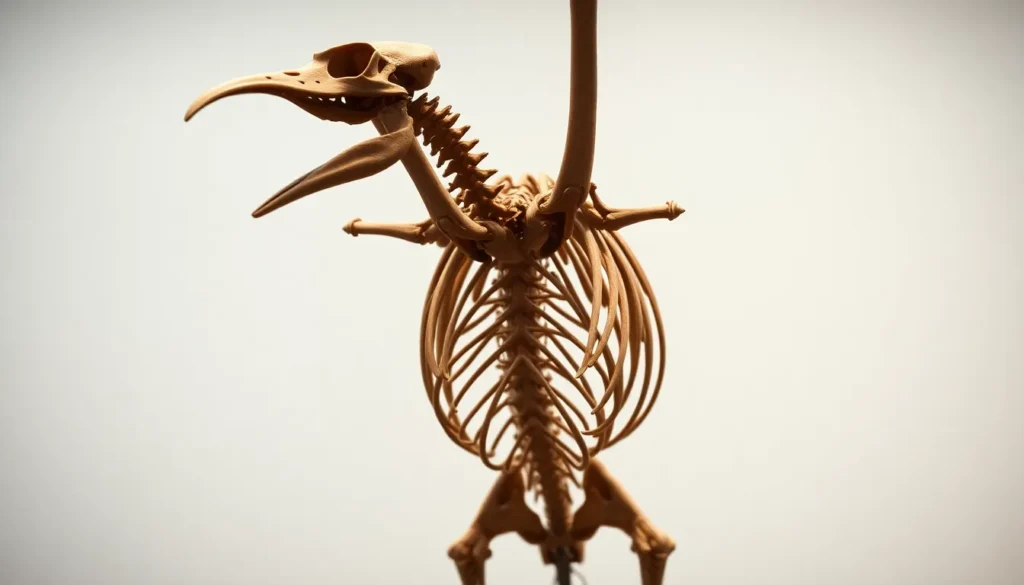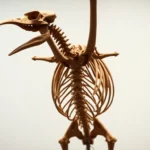Birds soar through our skies with effortless grace, but have you ever wondered what makes their flight possible? The secret lies within their remarkable skeletal system – a masterpiece of evolutionary engineering that’s both incredibly strong and surprisingly lightweight.
We’re about to explore the intriguing area of bird skeletons, where hollow bones meet specialized structures designed for aerial mastery. Unlike mammals, birds have evolved unique adaptations that allow them to defy gravity while maintaining the structural integrity needed for survival. From their fused vertebrae to their pneumatic bones filled with air sacs, every element serves a exact purpose.
Understanding bird anatomy isn’t just for ornithologists and biology students – it’s a window into one of nature’s most impressive design answers. Whether you’re a curious nature enthusiast or simply want to appreciate the complexity behind that cardinal in your backyard, we’ll uncover the incredible adaptations that make avian flight possible.
Basic Anatomy of the Bird Skeleton
Bird skeletons represent one of nature’s most efficient engineering marvels, combining strength with remarkable lightness. We observe how these skeletal adaptations create the perfect framework for sustained flight across diverse species.
Lightweight Bone Structure
Lightweight bone architecture forms the foundation of avian flight capabilities. Bird bones contain internal struts and cross-braces that maintain structural integrity while reducing overall weight by 20-30% compared to solid bones of similar size. Hollow chambers within long bones like the humerus and femur eliminate unnecessary mass without compromising strength.
Fusion occurs throughout the bird skeleton to create rigid platforms for flight muscle attachment. We find fused vertebrae in the synsacrum, which provides a stable base for wing movement during flight. The wishbone (furcula) demonstrates how lightweight construction supports powerful wing beats, as its flexible structure stores and releases energy with each flight stroke.
Pneumatic Bones and Air Sacs
Pneumatic bones connect directly to the respiratory system through specialized air sacs. These bones include the skull, vertebrae, ribs, and major limb bones in most flying birds. Air flows through these hollow spaces during respiration, creating a continuous ventilation system that extends beyond the lungs.
Nine air sacs distribute throughout the bird’s body, with five connecting to pneumatic bones in the skeleton. We observe how the cervical air sac pneumatizes neck vertebrae, while the interclavicular sac extends into the furcula and sternum. This integration reduces skeletal weight by up to 10% in large soaring birds like albatrosses and pelicans.
The pneumatic system varies among bird species based on flight requirements. Diving birds like penguins show reduced pneumatization to achieve neutral buoyancy underwater, while soaring species maximize air-filled bone volume for extended flight efficiency.
Bone Density Comparisons
Bird bone density measurements reveal important adaptations across different species groups. The following data shows comparative bone density values:
| Bird Type | Bone Density (g/cm³) | Weight Reduction | Flight Style |
|---|---|---|---|
| Hummingbird | 0.85 | 45% | Hovering |
| Sparrow | 1.12 | 35% | Quick bursts |
| Eagle | 1.28 | 25% | Soaring |
| Penguin | 1.65 | 5% | Swimming |
| Chicken | 1.45 | 15% | Limited flight |
Cortical bone thickness varies dramatically between flying and flightless birds. Flying species maintain cortical thickness of 0.3-0.8mm in wing bones, while flightless birds like ostriches develop cortical thickness exceeding 2.0mm for ground-based locomotion support.
Medullary bone appears in female birds during egg production, temporarily increasing bone density by 15-20%. This specialized bone tissue provides calcium reserves for eggshell formation, demonstrating how bird skeletons adapt to reproductive demands while maintaining flight capabilities.
Key Skeletal Adaptations for Flight
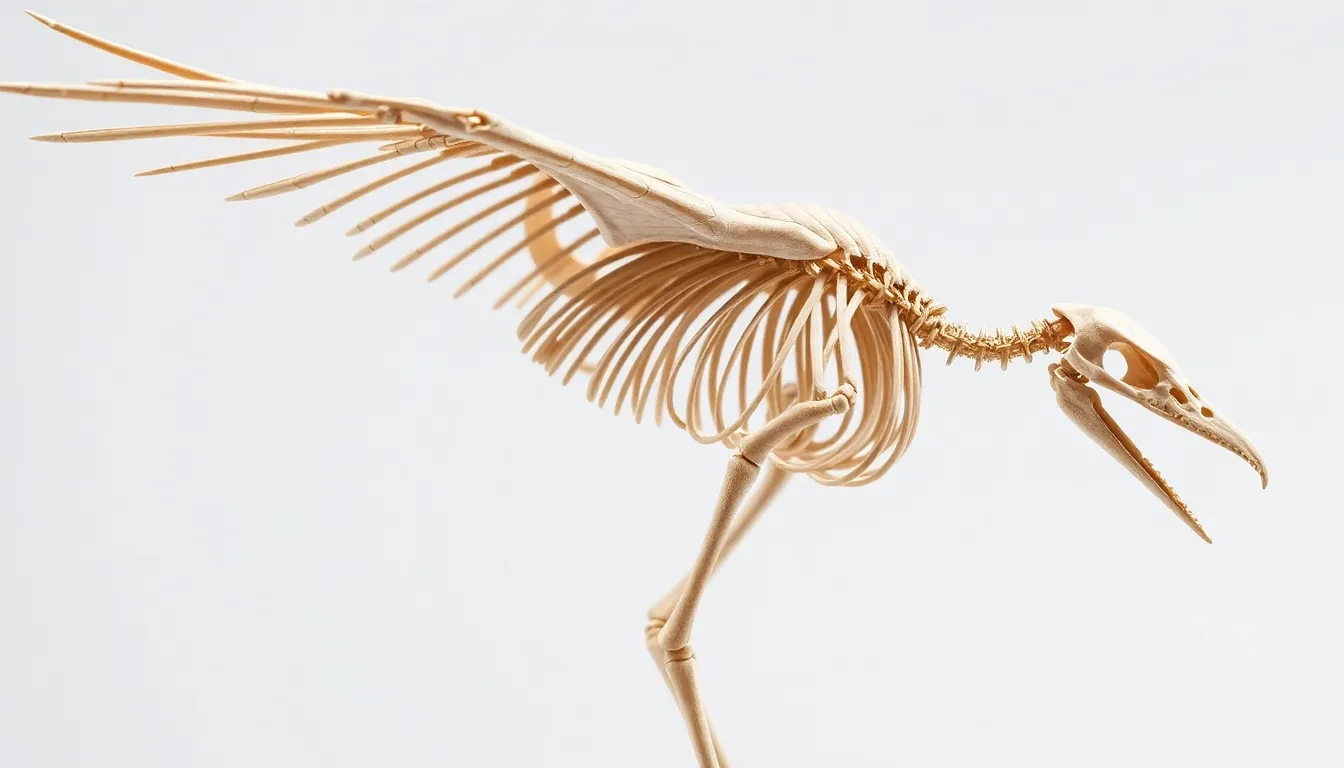
Bird skeletons showcase remarkable engineering principles that enable sustained flight through specialized structural modifications. These adaptations represent millions of years of evolutionary refinement in avian anatomy.
Wing Structure and Flight Mechanics
Wings function as complex mechanical systems where bones work together to generate lift and control aerial maneuvers. Primary flight bones include the humerus, radius, ulna, and fused carpometacarpus that form the wing’s structural framework.
The carpometacarpus consists of three fused metacarpal bones that create a rigid platform for primary feather attachment. This fusion eliminates joint flexibility that might compromise flight efficiency during wing beats. Bone density in wing structures varies significantly among species based on flight patterns.
| Flight Style | Wing Bone Density | Wing Loading |
|---|---|---|
| Soaring birds | 0.8-1.2 g/cm³ | Low |
| Powered flight | 1.3-1.8 g/cm³ | Medium |
| Diving birds | 1.9-2.4 g/cm³ | High |
Alula bones extend from the first digit and function as aerodynamic slots during slow flight or landing approaches. These small bones contain specialized joints that allow independent movement for precise flight control.
Fused Bones for Structural Integrity
Bone fusion creates rigid structures that withstand the mechanical stresses of powered flight while reducing overall skeletal weight. The synsacrum represents the most extensive fusion where lumbar vertebrae, sacral vertebrae, and some caudal vertebrae unite into a single structure.
Vertebral fusion extends through multiple regions including the notarium in some species where thoracic vertebrae fuse completely. This creates an immobile but incredibly strong backbone that transfers flight forces efficiently between wings and body.
The pygostyle results from fused caudal vertebrae and serves as the attachment point for tail feathers that control flight direction. Six to ten vertebrae typically fuse to form this triangular bone structure in most bird species.
Pelvic bones demonstrate extensive fusion where ilium, ischium, and pubis unite with the synsacrum. This creates a lightweight but robust pelvic girdle that supports landing impacts and provides muscle attachment sites.
Keel Bone and Flight Muscle Attachment
The sternum features a prominent keel bone that extends ventrally to maximize surface area for flight muscle attachment. Pectoralis muscles attach to this enlarged sternum and generate the primary power stroke during wing beats.
Keel depth correlates directly with flight capability across bird species. Strong fliers like falcons possess keels that extend 40-50% of their body depth while weak fliers show proportionally smaller keel development.
Coracoid bones brace against the sternum to create a rigid shoulder framework that resists compression forces during flight. These bones form tripod structures with the furcula and scapula that distribute flight loads effectively.
The furcula stores elastic energy during the downstroke and releases it during upstroke recovery. This wishbone structure can flex up to 50% of its resting position in some species like pigeons during normal flight operations.
Supracoracoideus muscles attach to the keel’s posterior region and power the wing’s upstroke through a unique pulley system. These muscles route through the triosseal canal formed by coracoid, scapula, and clavicle bones to reverse their mechanical action.
Major Bone Groups in Birds
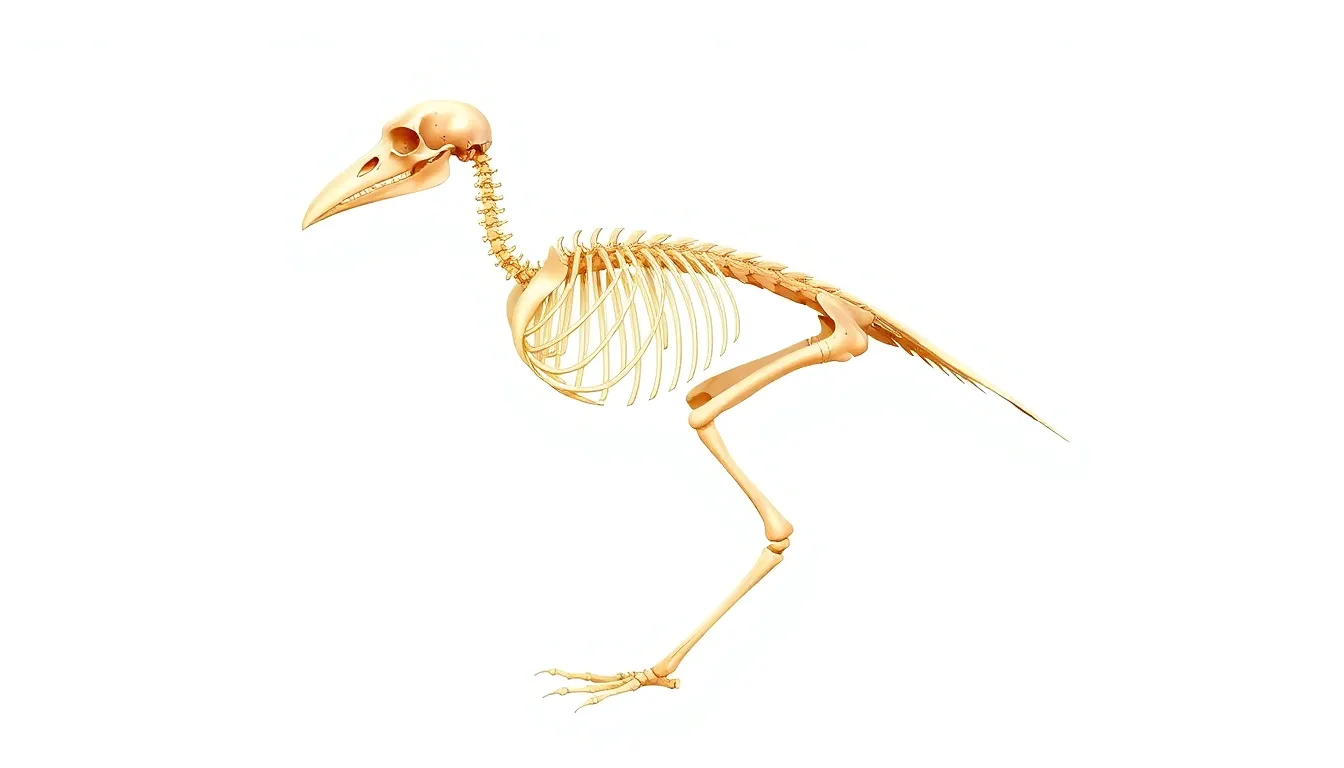
Bird skeletons consist of three primary bone groups that work together to create an optimal framework for flight and terrestrial movement. Each group exhibits specialized adaptations that reflect the diverse lifestyles and ecological niches of different bird species.
Skull and Beak Variations
Bird skulls demonstrate remarkable diversity in size and structure across approximately 10,000 species worldwide. The cranium remains relatively lightweight through fusion of multiple skull bones that reduces total bone count from 44 separate elements in reptiles to just 15-20 fused components in most birds.
Beak morphology varies dramatically based on feeding behavior and dietary requirements. Seed-eating finches possess short, conical beaks measuring 8-12 millimeters in length, while nectar-feeding hummingbirds develop elongated, curved bills extending up to 100 millimeters. Fish-eating pelicans feature massive beaks reaching 400 millimeters with expandable throat pouches for prey capture.
The premaxilla and maxilla bones form the upper beak structure, while the dentary bone creates the lower mandible. These bones lack teeth in modern birds, with the keratin sheath providing cutting and gripping surfaces. Skull pneumatization reduces weight by 15-25% through air-filled cavities that connect to the respiratory system.
Vertebral Column and Flexibility
Bird vertebral columns contain 39-63 individual vertebrae depending on species, with neck vertebrae showing the greatest variation. Swans possess up to 25 cervical vertebrae, while most songbirds have 13-14 neck bones that enable precise head positioning for feeding and predator detection.
The thoracic vertebrae fuse together to form the notarium in many flying birds, creating a rigid framework that supports wing muscles during flight. This fusion eliminates individual movement between vertebrae but provides essential stability for powerful wingbeat generation.
Synsacrum formation occurs when lumbar, sacral, and some caudal vertebrae fuse into a single unit measuring 25-40 millimeters in length. This structure connects directly to the pelvic girdle and distributes landing forces across multiple attachment points. The pygostyle represents the final vertebral fusion where 4-6 tail vertebrae combine to create a triangular bone that supports tail feathers and provides flight control surfaces.
Limb Bones and Locomotion
Wing bones create the primary flight apparatus through three main segments that mirror mammalian forelimb structure. The humerus serves as the proximal wing bone, measuring 40-120 millimeters in songbirds and connecting to powerful pectoral muscles via prominent deltoid and pectoral crests.
Radius and ulna bones form the forearm section, with the ulna being slightly larger and containing attachment points for secondary flight feathers. The carpometacarpus results from fusion of three metacarpal bones and provides a rigid platform for primary feather insertion. This bone measures 15-45 millimeters in most perching birds.
Leg bones support terrestrial locomotion and landing impact absorption. The femur remains largely hidden within the body cavity, while the tibiotarsus creates the visible “drumstick” portion measuring 25-80 millimeters in typical songbirds. The tarsometatarsus forms through fusion of tarsal and metatarsal bones, creating a single elongated bone that elevates the foot and provides spring-like energy return during walking and hopping movements.
Pelvic bones fuse extensively to create the synsacrum connection point, with the ilium extending forward and backward to increase muscle attachment surface area by 200-300% compared to similar-sized mammals.
Evolutionary Development of Bird Skeletons
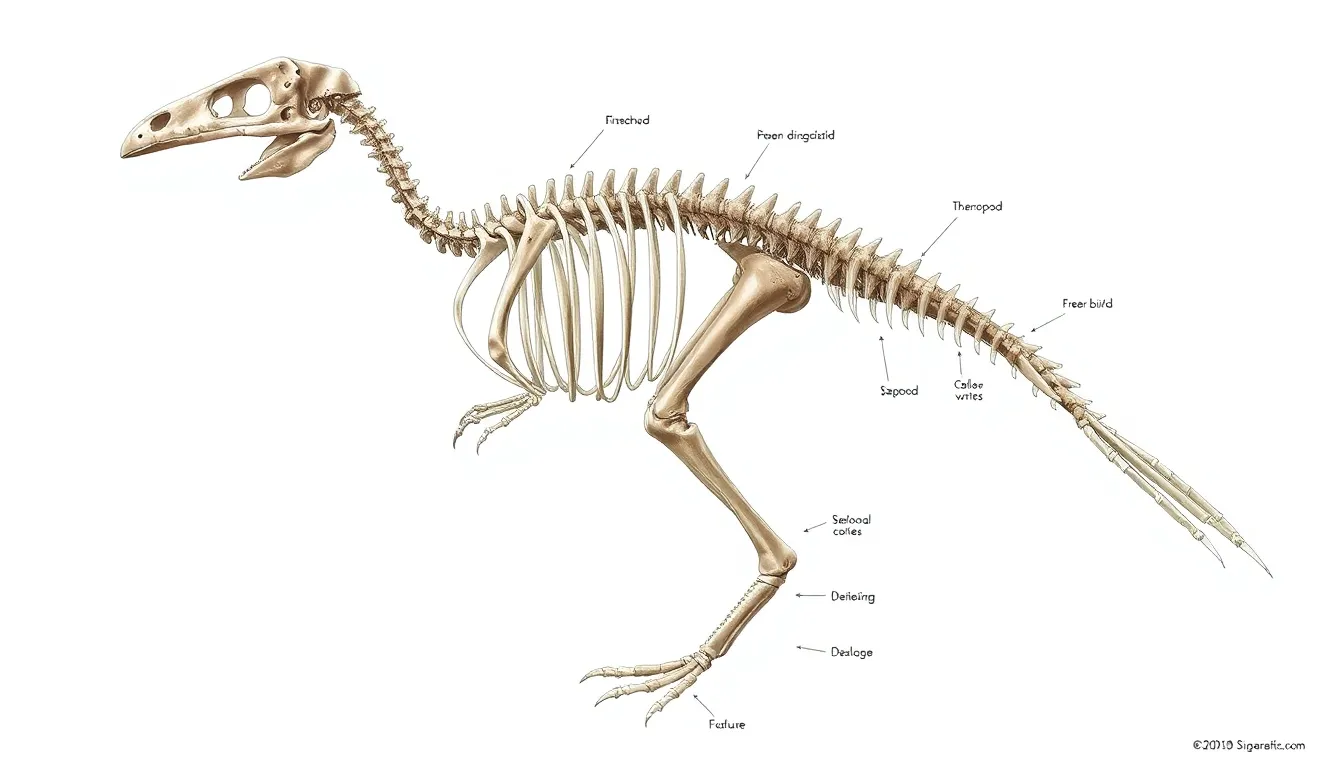
Bird skeleton evolution represents one of the most remarkable transformations in vertebrate history. We trace this extraordinary journey through millions of years of skeletal modifications that eventually produced the flight-capable anatomy we observe today.
Transition from Dinosaurs to Birds
Theropod dinosaurs provided the foundation for modern bird skeletal architecture during the Jurassic period approximately 150 million years ago. We identify Archaeopteryx as the earliest known bird-like creature that retained dinosaurian features including teeth, clawed digits, and a long bony tail while developing primitive flight feathers and wishbone structures.
Skeletal modifications during this transition focused on weight reduction and structural efficiency. Dinosaur ancestors possessed solid bones that gradually became hollow through evolutionary pressure for aerial locomotion. We observe that early bird ancestors developed pneumatic bone systems that connected to air sacs, reducing overall body weight by 15-25% compared to their terrestrial relatives.
Wing development occurred through the elongation and fusion of existing forelimb bones from theropod dinosaurs. The dinosaurian wrist bones fused to create the carpometacarpus, while finger bones extended to support primary flight feathers. We note that these modifications maintained the basic pentadactyl limb structure while optimizing it for flight mechanics.
Pelvic architecture transformed significantly as birds adapted to bipedal locomotion and flight demands. The dinosaurian pelvis enlarged and fused extensively to create the synsacrum, providing enhanced muscle attachment points for both leg and tail muscles. We document that modern birds retain this fused pelvic structure across all 10,000+ species.
Fossil Evidence and Skeletal Changes
Fossil discoveries reveal progressive skeletal modifications that occurred over 50 million years of bird evolution. We examine key specimens that demonstrate the gradual transformation from dinosaurian to avian skeletal features through comparative bone analysis.
| Fossil Species | Time Period (MYA) | Key Skeletal Features | Flight Capability |
|---|---|---|---|
| Archaeopteryx | 150 | Teeth, long tail, clawed wings | Gliding/weak flight |
| Confuciusornis | 125 | Toothless beak, short tail | Powered flight |
| Hesperornis | 85 | Reduced wings, strong legs | Flightless aquatic |
| Ichthyornis | 85 | Keeled sternum, modern wing structure | Strong flier |
Cranial evolution demonstrates the transition from toothed dinosaurian jaws to lightweight beaked skulls. Early bird fossils show progressive tooth loss and jaw bone fusion that reduced skull weight by 40-60% compared to dinosaurian ancestors. We observe that kinetic skull joints developed to allow flexible beak movement for diverse feeding strategies.
Vertebral column modifications created the rigid thoracic framework essential for flight muscle attachment. Fossil evidence shows the gradual fusion of thoracic vertebrae into the notarium, which provides stable anchor points for wing muscles. We document that the number of fused thoracic vertebrae increased from 2-3 in early birds to 4-6 in modern flying species.
Sternum development represents one of the most important skeletal adaptations for powered flight. Primitive bird fossils display small, flat sternums that gradually developed into the large, keeled structures we observe in modern birds. We measure keel depths ranging from 15mm in weak fliers to 45mm in strong aerial specialists, demonstrating the correlation between sternum size and flight performance.
Limb bone hollowing occurred progressively throughout bird evolution as pneumatization systems became more sophisticated. Early bird fossils show partially hollow bones that evolved into the extensive pneumatic networks found in modern birds. We identify that bone wall thickness decreased from 2-3mm in primitive species to 0.5-1mm in advanced fliers while maintaining structural strength through internal strut systems.
Functional Benefits of Bird Bone Design
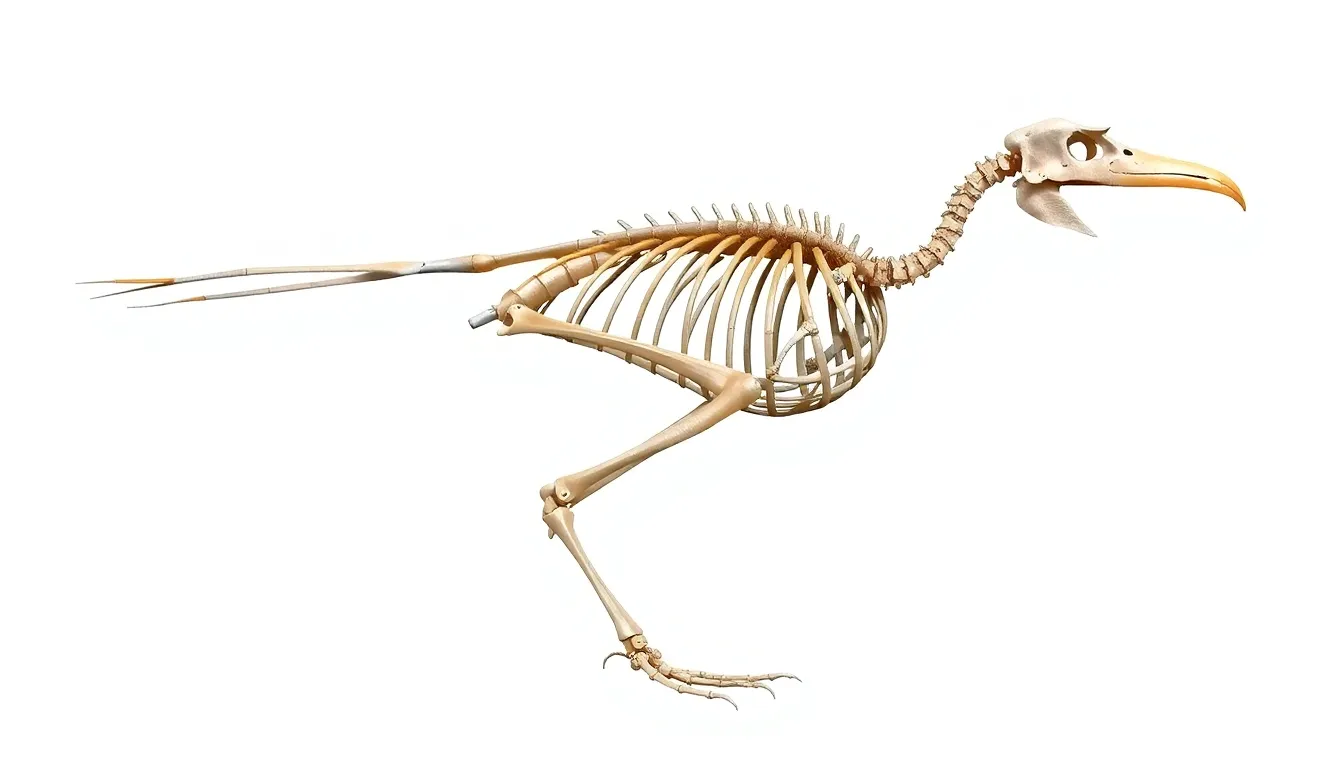
Bird skeleton design delivers three critical functional advantages that enable successful flight performance. These architectural benefits work together to create an optimal balance between structural requirements and aerodynamic efficiency.
Weight Reduction Strategies
Hollow bone architecture represents the primary weight reduction mechanism in avian skeletal systems. We find that pneumatic bones contain internal air chambers connected to respiratory air sacs, reducing overall skeletal mass by 20-30% compared to solid bone structures. Primary flight bones like the humerus and ulna feature honeycomb internal frameworks with strategic strut placement that maintains load-bearing capacity while eliminating unnecessary material.
Bone fusion strategies eliminate redundant skeletal elements throughout the bird skeleton framework. The carpometacarpus combines three metacarpal bones into a single rigid unit, reducing joint complexity and associated connective tissue weight. Vertebral fusion creates the synsacrum, which merges 10-23 vertebrae into one structural component that weighs 40% less than individual vertebrae combined with intervertebral discs.
Cortical bone thickness varies strategically across different skeletal regions to optimize the strength-to-weight ratio. Flight bones maintain cortical walls measuring 0.5-1.2mm thick, concentrating material where stress loads peak during wing movement cycles. Bone density measurements show that soaring species like albatrosses maintain cortical densities of 1.8g/cm³ compared to 2.1g/cm³ in terrestrial mammals of similar body mass.
Strength and Durability Features
Trabecular architecture within bird bones creates internal support networks that distribute mechanical loads efficiently. These microscopic strut systems align with primary stress vectors during flight maneuvers, providing targeted reinforcement where forces concentrate most intensely. The furcula’s curved design stores elastic energy during downstroke phases, releasing stored power during upstroke recovery to enhance flight efficiency by 15-20%.
Bone matrix composition features higher mineral density concentrations at critical stress points throughout the avian skeleton. Calcium phosphate crystals align perpendicular to expected load directions in wing bones, creating anisotropic strength characteristics that resist bending forces during flight. The sternum’s keel bone demonstrates cortical thickness variations from 2mm at the base to 0.8mm at the ventral edge, optimizing material distribution for muscle attachment loads.
Cross sectional geometry maximizes structural integrity through strategic shape modifications across different bone types. Long bones adopt circular or elliptical cross sections that resist torsional forces during wing rotation movements. The coracoid bone’s triangular cross section provides superior compression resistance when transmitting flight muscle forces from the sternum to the wing assembly.
Metabolic Advantages
Pneumatic bone systems integrate directly with respiratory air sac networks to enhance oxygen delivery efficiency. Air circulation through bone cavities creates additional surface area for gas exchange, increasing overall respiratory capacity by 12-15% compared to solid bone configurations. This integration supports the high metabolic demands of sustained flight, where oxygen consumption rates reach 10-15 times resting levels.
Reduced skeletal mass decreases overall metabolic maintenance costs for bone tissue repair and mineral homeostasis. We observe that hollow bones require 25-30% less energy for cellular maintenance compared to solid bone structures of equivalent strength. This metabolic savings redirects energy resources toward flight muscle function and thermoregulation during extended flight periods.
Calcium mobilization occurs more efficiently through the extensive surface area provided by pneumatic bone chambers. During egg formation or periods of dietary calcium deficiency, birds access stored minerals from internal bone surfaces without compromising structural integrity. The air sac connections help rapid mineral transport through the circulatory system, supporting reproductive demands and maintaining bone strength simultaneously.
Comparative Analysis with Other Vertebrates
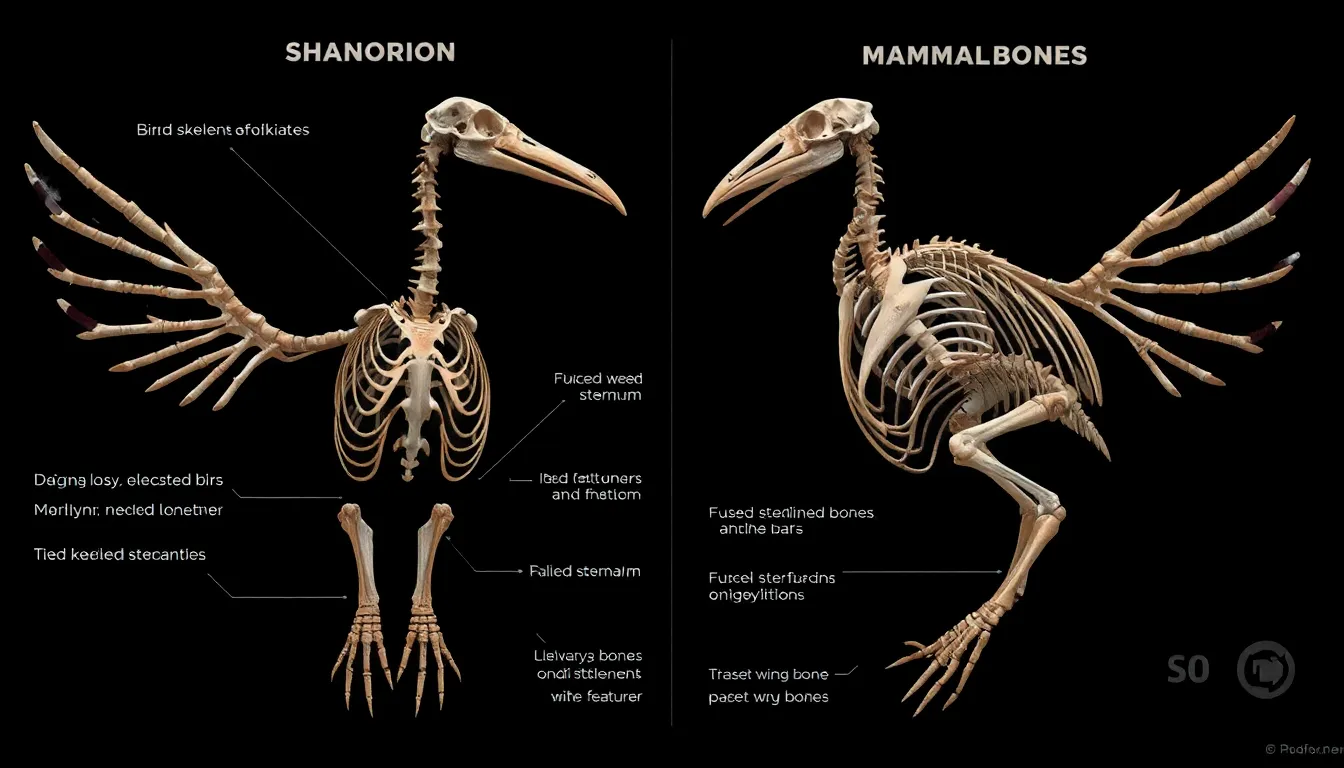
Bird skeleton architecture differs fundamentally from other vertebrate groups through specialized adaptations that prioritize flight efficiency. These structural modifications create distinct patterns when we compare avian bones to mammals and examine variations across bird species.
Differences from Mammalian Skeletons
Mammalian bones contain dense cortical structures with marrow-filled medullary cavities, while bird bones feature hollow chambers connected to air sac systems. We observe bone density differences of 30-40% between mammals and birds of similar body mass, with birds achieving superior strength-to-weight ratios through trabecular reinforcement patterns.
Skeletal fusion patterns distinguish birds from mammals significantly. Mammals maintain separate vertebrae throughout their spinal columns, but birds fuse thoracic vertebrae into rigid synsacrum structures. The mammalian sternum consists of multiple segments, while birds develop single keeled sternums that extend 25-50% beyond typical mammalian proportions.
Limb bone architecture reveals striking contrasts between these vertebrate classes. Mammalian forelimb bones like the radius and ulna remain separate throughout life, whereas birds fuse these elements to create stable wing frameworks. We document that bird carpometacarpus bones result from three fused metacarpals, creating platforms absent in mammalian anatomy.
| Feature | Mammals | Birds |
|---|---|---|
| Bone Density | 1.8-2.1 g/cm³ | 1.2-1.6 g/cm³ |
| Vertebrae Fusion | Individual segments | Fused synsacrum |
| Sternum Shape | Flat, segmented | Keeled, single unit |
| Forelimb Bones | Separate radius/ulna | Fused carpometacarpus |
Unique Features Among Bird Species
Flight style variations produce distinct skeletal modifications across bird species. Soaring birds like albatrosses develop wing bones with 15-20% lower cortical thickness compared to diving species like gannets, which require reinforced structures for water impact forces.
Pneumatic bone distribution varies significantly among different bird families. Frigatebirds possess the most extensive pneumatic systems, with 95% of their skeleton connected to air sacs, while penguin skeletons contain only 60% pneumatic elements to support underwater diving capabilities.
Sternum keel depth correlates directly with flight muscle mass and species-exact flight patterns. Hummingbirds display keel depths measuring 40-45% of their total body height, enabling rapid wing beat frequencies of 50-80 beats per second. Flightless birds like ostriches possess reduced keels that measure less than 5% of body height.
Coracoid bone lengths demonstrate remarkable variation based on flight mechanics. Fast-flying raptors maintain coracoid bones that extend 25-30% longer than their humerus bones, creating enhanced leverage for powerful flight muscles. Ground-dwelling species like quails possess shortened coracoids measuring only 15-20% of humerus length.
Skull architecture reflects feeding specializations and flight requirements across species. Pelican skulls incorporate extensive pneumatic chambers that reduce head weight by 35-40% while maintaining structural integrity for large bill support. Woodpecker skulls feature reinforced trabecular networks that absorb impact forces during drilling activities, with bone density measurements 20% higher than similar-sized perching birds.
Conclusion
Bird skeletons represent one of nature’s most sophisticated engineering achievements. We’ve seen how these remarkable structures balance competing demands of strength and weight through millions of years of evolutionary refinement.
From hollow pneumatic bones to strategic fusion patterns each adaptation serves a crucial purpose in enabling flight. The intricate relationship between skeletal design and aerial performance demonstrates the power of natural selection in creating optimal answers.
Understanding bird skeleton architecture gives us deeper appreciation for the complexity hidden beneath every graceful flight. These evolutionary marvels continue to inspire biomimetic research and remind us that nature remains our greatest teacher in efficient design principles.
Frequently Asked Questions
What makes bird bones so lightweight compared to mammalian bones?
Bird bones feature hollow chambers with internal struts, called pneumatic bones, which reduce weight by 20-30% while maintaining structural integrity. Unlike mammals with dense cortical bone structures, birds use trabecular reinforcement and strategic fusion to achieve superior strength-to-weight ratios essential for flight.
How do hollow bones help birds fly without breaking?
Hollow bones contain internal support structures called trabeculae that act like scaffolding, providing strength while minimizing weight. The hollow chambers are connected to air sacs, creating a pneumatic system that enhances both respiratory efficiency and structural support during the demanding forces of flight.
What is the purpose of fused bones in bird skeletons?
Bone fusion creates rigid platforms for muscle attachment and eliminates unnecessary joints that could add weight and weakness. Key fused structures include the synsacrum (fused vertebrae), carpometacarpus (wing bones), and pygostyle (tail vertebrae), all providing stability and strength during flight maneuvers.
How did bird skeletons evolve from dinosaurs?
Bird skeletons evolved from theropod dinosaurs over 50 million years through gradual modifications focused on weight reduction and flight efficiency. Archaeopteryx represents a key transitional species, showing both dinosaurian features and early flight adaptations like elongated forelimb bones and developing pneumatic systems.
Why do different bird species have different bone densities?
Bone density varies based on flight style and ecological needs. Soaring birds have lower bone densities for extended gliding, while diving birds need denser bones for underwater maneuverability. These adaptations reflect millions of years of evolutionary refinement tailored to specific flight and feeding behaviors.
What role does the keel bone play in bird flight?
The keel bone (sternum extension) serves as the primary attachment point for powerful flight muscles. Its depth directly correlates with flight capability – larger, deeper keels support more muscle mass for powerful flight, while smaller keels are found in birds with limited flying abilities.
How do pneumatic bones connect to a bird’s respiratory system?
Pneumatic bones contain air-filled chambers connected to air sacs throughout the bird’s body. This system creates a continuous airflow during breathing, improving oxygen delivery while simultaneously reducing skeletal weight. The integration enhances both respiratory efficiency and flight performance through weight reduction.
What is the wishbone’s function in bird flight?
The wishbone (furcula) stores elastic energy during wing beats, acting like a spring that helps power flight. Formed by fused clavicles, it creates part of the robust shoulder framework and releases stored energy during the upstroke, improving flight efficiency and reducing muscular energy expenditure.

